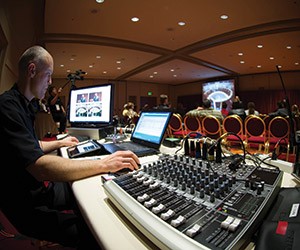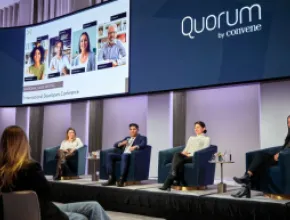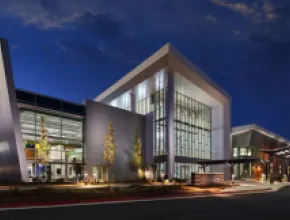With 16 years of broadcast experience and 14 years handling live events, Emilie Barta has taken a leadership role in the rapidly evolving world of hybrid events.
Barta has been hosting webcasts since 2001, and in 2005 when the economy began to limp and planners looked to virtual events as a cost-cutting measure, she began working to make hybrid events productive—even enjoyable—for virtual attendees, she has never looked back.
She defines a “hybrid” event as when a physical and virtual event happen simultaneously and allow the audience of both to participate equally.
Barta pioneered the role of a “virtual emcee,” where she serves as a translator to foster communication between planners, vendors, producers and consultants during the planning stages, and guides virtual attendees through the actual event.
Attendees at a live conference can whisper to their neighbor or ask questions when they are confused, but, alas, participants sitting in front of their computer have no one to turn to, so Barta, in essense acts as their conduit.
She will chat with the attendees online or talk to them directly via a dedicated camera, explaining delays, communicating instructions and making their voices heard.
Actively Engaged
According to Barta, the goal of hybrid events is to extend the experience to the audience unable to attend. When done well, they can create an engaging digital atmosphere and add depth to an event.
“Live streaming can create buzz for events and organizations and be a great tool to increase awareness. It offers a low-risk way for potential members to test the waters and get insight,” says John Pollard, event services program director for Sonic Foundry’s MediaSite branch.
MediaSite is a leading webcasting company, offering live streaming, hybrid event support and analytics.
Planners often fear that hybrid meetings will create more work or cannibalize in-person attendance, and Pollard concedes that it does add a long list of considerations, “but the payoffs are absolutely tremendous,” he says. “When executed well, it can be a powerful tool to increase revenue, attendance and satisfaction of both live and virtual attendees.”
When planning a hybrid event in a convention center, Barta outlines numerous considerations that will set a professional tone.
The list includes space (Is there room to set up an area for the virtual emcee to work from?); electricity (Are there enough outlets nearby?); video composition (Will the background color make the subject stand out or disappear? Are there debris or empty storage bins in the frame?); and, of course, connectivity (Free Wi-Fi is essential to interaction between the live and virtual audiences.).
Looking to the Future
“There are a lot of poorly constructed hybrid events that are created without thought to the virtual audience, and one bad experience can cause people to tune out and write off virtual events in the future,” Barta says. “My hope is that in the future, conference organizers and planners will develop their virtual components from the beginning and not as an afterthought,” she says.
Multimedia content gleamed from hybrid events can also be utilized in blogs, newsletters and via social media channels.
But despite the massive potential of digital technology and hybridization, it’s important to start with manageable changes.
“It’s still a relatively new thing, and there are always growing pains,” Pollard says. “Unless you have a huge budget, it makes sense to step into it simply and add complexity as you learn.”






